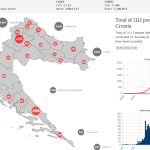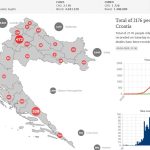September the 16th, 2019 – Although the article which covered the ten myths of Croatian tourism was written by Tonči Tadić a whole decade ago, all of his ten points (or rather, myths) are still very relevant, suggesting that little has changed, if anything at all.
”I consider it my duty to warn people about the fact that tourism revenue is much more modest than the typical perception of it is, that foreigners make much more money on tourism than Croats do, and that tourism, by all relevant indicators, doesn’t affect the significant reduction of unemployment at all, nor does it encourage the development of the country more than some quality industry would,” Tadić initially wrote for Politika.com.
In the 1970s, you could easily become a hotelier in France if you agreed to a French project, with a French contractor, the use of French equipment, food and drinks, the employment of a French workforce and the proper payment of taxes to the French state.
In the case of Croatia, Tadić thinks that we have little other than the following ten tourism myths:
Myth 1: Tourism is a magic wand that will solve the unemployment problem in Croatia
Unfortunately, Croatian tourism is still almost only a seasonal activity. The self-construction of apartments is also a myth in terms of self-employment, because the return on investment is very slow and these apartments are empty for most of the season. The development of Croatia in the direction of tourism alone means that the most desirable occupations in Croatia are that of a trained waiter and a trained maid. This is the path to the complete de-industrialisation and de-intellectualisation of Croatian society.
Tourism should be seen as the icing on the cake of the entire economy, of which part of the product is marketed through tourism. It’s a mistake to think that it is incompatible with production, of course, in an environmentally friendly manner. If that were the case, there would be no tourists in Italy, Austria, Germany or Japan!
Myth 2: Croatia has a high tourism revenue
The Croatian National Tourist Board has a practice of defining the success of a season by counting the number of overnight stays realised, although nobody in Europe does that anymore. There, [in Europe] long after the season, they count euros and not overnight stays. In our country, it’s different because the Croatian National Tourist Board generates income from sojourn taxes, so for them, only the number of overnight stays is important. But estimates of real tourism revenue vary. All of the research shows that the average tourist spends a maximum of one month’s salary when on holiday and not a cent more.
Myth 3: Tourism is used to market local products
It is a notorious fact that the import of food and beverages for tourism is increasing year after year, in other words, Croatian tourism contributes to the development of agriculture in Hungary, Italy, Serbia, Macedonia, etc., but not in Croatia. The hotel equipment is also imported because we’ve destroyed the domestic production of furniture and appliances. Unfortunately, Croatia does not have any mechanisms to promote its domestic tourism products, except through slogans before elections, and nobody remembered to resort to lending to tourism companies in order for them to purchase only domestic products.
Myth 4: Tourism is overburdened with taxes
Nobody has explained to a large number of people in tourism that this is a low-accumulation branch of an economy where there is no quick profit. This is why today, everyone is whining about the heavy tax burden. Croatian tourism simply needs to be brought into the same business environment as other countries in the Mediterranean have done with theirs. Since 2005, a 10 percent VAT intermediate rate has been introduced for tourism accommodation – when it comes to our competition, the rate is 7 to 11 percent.
There is room for a shift in converting sojourn tax into an extraction from income tax. Anyway, tourists and locals don’t get anything from it. Why should one kuna from sojourn tax not go towards improving healthcare in the season?
Myth 5: Croatia is an expensive destination
It’s interesting how this story starts every June, when the “June slump” is usually used, ie, there are fewer overnight stays, because the pensioners return from their holidays in the preseason and the school year is not over yet – when the data from the preseason is analysed. That data shows that only Turkey is cheaper than Croatia. But the real question is, what do we offer for those prices that we raise by 10-20 percent per year, but with the same offer? Nobody is foolish enough to throw their hard-earned money at our desperate bid.
Myth 6: Tourism preserves the environment more than industry
Tourism leads to a lot of human traffic, it requires a lot of space for construction and creates a burden for infrastructure. The environment can also be guarded by environmentally friendly industries or by fisheries and mariculture. The current element in tourism erodes the most valuable resource on the Adriatic, which is unpolluted and undeveloped space both on land and at sea.
Disruptive landfills, unregulated sewage, traffic collapsing, not to mention water supply problems, contribute to the destruction of the environment and the discomfort of residents. No other branch of the economy would tolerate it, but with tourism then it is tolerated!?
Myth 7: Tourism, especially the elite type, brings in the fastest development
Just as the slogan of industrialisation + electrification = communism used to be sold, nowadays the saying goes: marinas + golf courses = elite tourism, and now that’s being sold.
However, it’s forgotten that this is not only achieved through the construction of a golf course or just the construction of marinas, but through a complete offer. What do we offer that “elite tourist” when he leaves his “elite hotel”, his “elite marina” and his “elite golf resort”?
In addition to that, how is it possible to plan golf courses along the coast and not, for example, do so in the Dalmatian hinterland? I’m afraid that golf actually serves as a cover-up for building hotels along the grounds. I’m not against marinas either. But is it not better to bring yachts to our ports in our towns on the coast and islands and provide income to their inhabitants (but first to secure moorings for the local population). It goes without saying that those wishing to moor at our ports should pay some kind of “monumental rent” for this luxury.
Myth 8: All tourist facilities should be privatised
It’s absurd to claim that the state is a bad master and that it should withdraw from tourism, and on the other hand, seek a stronger involvement from it in subsidising tourism. If tourism is profitable, why should the state not benefit from it? And if not, then why should it subsidise a private individual? If the problem is incompetent management, then that needs to be changed, and that doesn’t require a new owner. It is even more stupid to bring in a private owner, and a foreign owner at that, and then bail him out when he gets into too much debt, as the state does for the ORCO group in ”Sunčani Hvar”.
Myth 9: Tourism should dictate spatial plans
Under the dictates of tourism, Croatian ports are slowly losing their operational coast. Every place on the Adriatic today is planning a marina, but not an alternative communal port for the locals; it’s planning a hotel or apartment complex, but not a factory. Construction firms, law firms and real estate agencies are the only ones that have a quick return on tourism when building a hotel. However, it’s absurd for Croatia that the development of tourism is not dictated by the Croatian state, nor the Croatian economy, or even the tourism companies themselves, but by construction lobbies.
Myth 10: Tourists are not interested in Croatian heritage, but want an “international offer”
Tourists, on the contrary, want exclusivity and an indigenous offer.
After all, the offer is no different from the competition, so in that variant, the only way out is to reduce prices. But we still don’t have an indigenous Croatian brand in our diet or accommodation, apart from the kabobs and skewers.
When and where did you hear about a “Croatian restaurant”? There are Italian, Argentinean, Spanish, Japanese, Chinese, Indian, Hungarian, French, Greek restaurants in almost all EU countries, but you will hardly find anything called a Croatian restaurant. Nor do we have our own indigenous food supply. When you’re in one of these countries, you know which dishes to try. But which dishes in this country are declared as Croatian national dishes in our restaurants and in our tourist offer?










